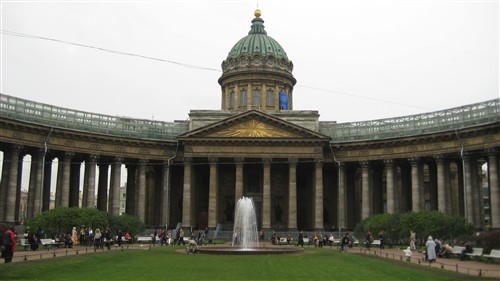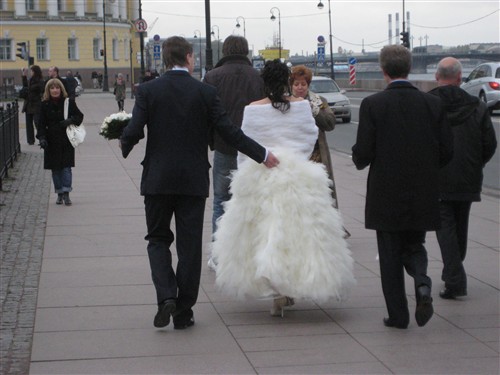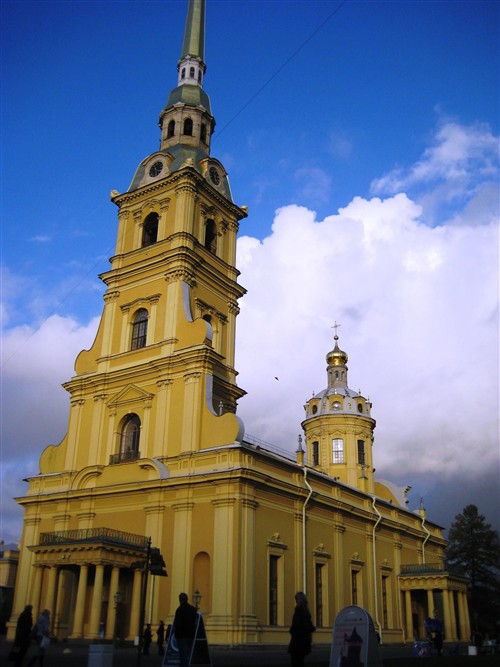Posted under Russia

By Russian standards, the gray windy, drizzling, cold weather of late October is a mild prelude to a harsh northern winter but, to two traveling vagabonds who have spent the past fourteen months chasing the warm weather around the globe, it’s freezing! While the initial blast of cold wind in your face may invigorate you, walking around in it for extended periods of time quickly depletes your energy reserves. We have already noticed how much less we can see and do in a day before retiring early to hot drinks and comfort food.
On day three in St Petersburg, we bundled up and set out with an ambitious program of sightseeing. We intended to walk quite far across the river to the historic St Peter & Paul Fortress and then catch the metro back to Nevsky Prospekt. Not realizing how far the fortress was when we had spotted it in the distance the previous day, we decided to check out some of the beautiful old churches around our neighborhood on the way.

Heading toward the Church on the Spilled Blood, we stopped at the Kazan Cathedral, built in the early 19th century. From Nevsky Prospekt, the main shopping street, the cathedral’s long colonnaded arms reach around into a semi-circle, creating a lovely courtyard with a green space, park benches, and a fountain. From this angle, you can hardly tell that it is a church since the chapel extends from the rear.
Behind the Church on Spilled Blood is the city’s best souvenir market and we wandered through the colorful stalls to check out the matryoshki (Russian nesting dolls) and wood-carved figurines for which Russia is famous. The wares were lovely, though priced to haggle. Not surprisingly, it was here that we heard the most English spoken. Each vendor had a small cart and wanted to show me every detail of every item that I glanced at, whispering so many things into my ear that I couldn’t think straight. Finally, I went berserk (but kept it on the inside) and high-tailed it out of the souvenir market with pockets full of rubles and no treasures. We have been in Europe for so long that I wasn’t prepared for the high-pressure sell.
St Isaac’s Cathedral, built between 1818 and 1858, was the largest church in Russia at that time. It was built on the plan of a Greek cross with a tall gold dome that later inspired the design of the United States Capitol in Washington, D.C. During the Soviet era, the church was closed down and re-opened as a museum of atheism. The gold dome was painted over in gray during WWII to conceal it from air raiders. Today, part of St Isaac’s is used for regular church services while the main chapel is only used for feast days. I suspect that this is largely due to the fact that, while the vast majority of Russians classify themselves as Orthodox Christians, only a small fraction reportedly practice their faith.
 After St Isaacs, we finally headed to the river, across the bridge toward the St Peter & Paul Fortress. It was a Thursday afternoon so we were pleasantly surprised when we came upon several small wedding parties on the Strelka (tongue of land) on Vasilevsky Island. The young brides wore pristine white furs around their otherwise bare shoulders. The happy couples were surrounded by musicians and boisterous revelers. We observed two interesting wedding traditions as we discreetly watched from above. At the river’s edge are several granite spheres and the couple must simultaneously throw two glasses against the sphere, smashing them to pieces and inciting cheers from the crowd. Then they light the wick of a small cannon, which shoots firecrackers over the Neva to the sound of more applause.
After St Isaacs, we finally headed to the river, across the bridge toward the St Peter & Paul Fortress. It was a Thursday afternoon so we were pleasantly surprised when we came upon several small wedding parties on the Strelka (tongue of land) on Vasilevsky Island. The young brides wore pristine white furs around their otherwise bare shoulders. The happy couples were surrounded by musicians and boisterous revelers. We observed two interesting wedding traditions as we discreetly watched from above. At the river’s edge are several granite spheres and the couple must simultaneously throw two glasses against the sphere, smashing them to pieces and inciting cheers from the crowd. Then they light the wick of a small cannon, which shoots firecrackers over the Neva to the sound of more applause.
From the Strelka, we walked another half-hour or so before finally reaching the walls of the St Peter & Paul Fortress. It was built in 1703 to protect the city but was mainly used as a prison until 1917. We walked around the sandy shore of the Neva River, along the tall fortress walls, looking for the entrance. The grounds of the fortress were free to visitors and, inside, we saw many people enjoying a stroll around the quaint old buildings. The primary attraction is the St Peter & Paul Cathedral – a small yellow baroque church with a needle thin spire. It houses the tombs of all of the Russian tsars since Peter the Great.
 Tired and cold after our busy program, we walked briskly toward the nearest metro stop. On the way, we spotted some blue mosaic onion domes protruding above the tree line. We detoured a few steps to get a closer look and realized that we had stumbled upon the Saint Petersburg Mosque – the most northerly mosque in the world. When it was built in 1913, it was the largest mosque in Europe.
Tired and cold after our busy program, we walked briskly toward the nearest metro stop. On the way, we spotted some blue mosaic onion domes protruding above the tree line. We detoured a few steps to get a closer look and realized that we had stumbled upon the Saint Petersburg Mosque – the most northerly mosque in the world. When it was built in 1913, it was the largest mosque in Europe.
When we finally reached our metro stop, we were beyond ready to get back to our warm cell at the hostel. Imagine our disappointment when we found that our metro stop was closed. Our hearts sank but it was simply too cold to dwell on our misfortune so we quickly headed in the direction of the next closest stop as drizzling rain began to fall. The metro stops in Saint Petersburg are very spread out and, by the time we reached the vicinity of another stop, we were already at the river and determined that walking the rest of the way would be just as easy as navigating our way through Russian signage to the metro stop.
By the time we reached the door of the hostel, I was overcome with love for our little communist era cell. We don’t need much these days, just a warm place to lay our heads so that we can recover enough from the day’s exploits to run ourselves ragged yet another day.
Comments Off on Searches for Churches
